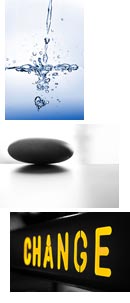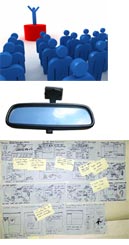 Yep, it's here, a brand new year, as empty as a cup, full of nothing but potential. In the recent documentary The Promise Bruce Springsteen talks about this in relation to concerts. He says that despite all the preparation, the selection of songs, the endless rehearsals, as he steps on the darkened stage, nothing exists but the potential of performance. The new year beckons as a stage for your preparation. Here is one of my three goal points as I've prepared for 2011:
Yep, it's here, a brand new year, as empty as a cup, full of nothing but potential. In the recent documentary The Promise Bruce Springsteen talks about this in relation to concerts. He says that despite all the preparation, the selection of songs, the endless rehearsals, as he steps on the darkened stage, nothing exists but the potential of performance. The new year beckons as a stage for your preparation. Here is one of my three goal points as I've prepared for 2011:
 In the area of NEW PROGRAMS, I am launching three new and upgraded programs this year:
In the area of NEW PROGRAMS, I am launching three new and upgraded programs this year:
- The Curious Clarity of Teams: As the pace of what we do continues to accelerate, the advantage of well developed and positioned teams will grow in importance. This program shows how to design, develop, and apply the single core aspect of team success, clarity.
- A Simple Step: Of all the services I provide, the most asked about involves the methods of simplifying processes, systems and ideas. I am combining all of my simplicity programs into a single program that utilizes all three of my delivery models, as a presentation, as a curriculum that can be taught, and as part of our consulting services for direct application to companies' internal operations.
- The Chaos Conspiracy: This is my program on change and continues to be one of the most requested presentations of the past decade. The program has received a complete facelift in the past few months and makes its new debut this month.
Create your potential by a simplified, impactful plan for every day of 2011.
January starts off like December ended. I will have the honor of working with clients in Atlanta, Minneapolis (brrrr), Austin, San Antonio, Cleveland (brrrr) and San Francisco!
Here is a neat, little piece that appeared in Dallas Business Journal:

See the entire article here, online.
The Architecture of Presentation
All architecture is shelter, all great architecture is the design of space that contains, cuddles, exalts or stimulates the person in that space. -Philip Johnson
 Think about this: we are all in the idea business. It might be the idea of a new sales initiative or a revised compensation plan. Perhaps it's an acquisition or a new office opening. Maybe it's a product launch. It doesn't matter what the "it" is, it is above all a new idea. And how does an idea gain power? What makes it exciting? It's all about engagement. Engagement provides the traction that gives any idea its power. And one of the key engagement tools is how the idea is presented. The idea becomes launched and begins fighting for its traction when the idea is presented to those impacted by its effect. Presentation is critical.
Think about this: we are all in the idea business. It might be the idea of a new sales initiative or a revised compensation plan. Perhaps it's an acquisition or a new office opening. Maybe it's a product launch. It doesn't matter what the "it" is, it is above all a new idea. And how does an idea gain power? What makes it exciting? It's all about engagement. Engagement provides the traction that gives any idea its power. And one of the key engagement tools is how the idea is presented. The idea becomes launched and begins fighting for its traction when the idea is presented to those impacted by its effect. Presentation is critical.
 If this is the case, why then do most presentations suck? I'm deadly serious. I see more presentations than my entire reading audience (now at about 5,000) combined, so rest assured, I know what I'm talking about when I say the current state of most presentation material and its delivery is as dismal as a nuclear winter. I often think, "Oh, I get it. The purpose of this presentation is to send the entire audience to the window, where they will fight for the chance to jump first. Well done, marketing department. Well done, poorly trained and prepared presenter. Well done!"
If this is the case, why then do most presentations suck? I'm deadly serious. I see more presentations than my entire reading audience (now at about 5,000) combined, so rest assured, I know what I'm talking about when I say the current state of most presentation material and its delivery is as dismal as a nuclear winter. I often think, "Oh, I get it. The purpose of this presentation is to send the entire audience to the window, where they will fight for the chance to jump first. Well done, marketing department. Well done, poorly trained and prepared presenter. Well done!"
I understand how it happens. Most people have no idea that there is architecture behind great presentation design. In addition, most presenters have received at best only cursory training in presentation skills. Combine these two inadequacies, and you get mind-numbing, blackberry-texting, non-connecting, window-jumping presentations…that suck.
 So let's stop this right now. Hey, companies! If you are trying to gain a level of engagement, start with the first time anyone is going to hear about this new idea. Is it going to be an email (horrible choice, but sometimes necessary)? Design it to be impactful! Better yet, let's assume it's a stage presentation for those to be affected or involved. Here are some concepts from my program The Architecture of Presentations:
So let's stop this right now. Hey, companies! If you are trying to gain a level of engagement, start with the first time anyone is going to hear about this new idea. Is it going to be an email (horrible choice, but sometimes necessary)? Design it to be impactful! Better yet, let's assume it's a stage presentation for those to be affected or involved. Here are some concepts from my program The Architecture of Presentations:
 PERPSECTIVE: Great design starts at the perspective of the impacted, NOT from the perspective of the designer or speaker. Start your thinking from a seat in the audience. Literally go to a large room (if you don't have one at the office, take the time to go to an empty hotel meeting room) and sit down with a sketch pad. Face the stage and think to yourself, How do I want the audience to feel? What do I want them to think? How do I want the message delivered? This is the critical starting point, not your files of detailed outlines, charts, and data.
PERPSECTIVE: Great design starts at the perspective of the impacted, NOT from the perspective of the designer or speaker. Start your thinking from a seat in the audience. Literally go to a large room (if you don't have one at the office, take the time to go to an empty hotel meeting room) and sit down with a sketch pad. Face the stage and think to yourself, How do I want the audience to feel? What do I want them to think? How do I want the message delivered? This is the critical starting point, not your files of detailed outlines, charts, and data.- THE REARVIEW MIRROR: Now think about the "future past." Though the program has not yet been delivered, ask yourself (and answer): "What do I want them to walk away with when the program is in their past?"
- THE STORYBOARD: Now that you have a few notes and you have your design mind in the right place, DON'T start building the presentation! That's a jump in the process. Instead, begin "seeing" the idea. Create a simple storyboard that shows how the idea moves. This is the beginning of the visual journey that will encompass the idea. It's amazing that most presenters think a presentation is only auditory. But it's also very visual.
 This is the beginning of creating a vehicle that will launch your idea with real traction being your outcome.
This is the beginning of creating a vehicle that will launch your idea with real traction being your outcome.
There is NO EXCUSE for horrific presentations. If you don't know how to design a presentation, learn! It's a learnable skill. Don't condemn the participants to another meaningless hour where the potential for impact is left at the door. Mediocre presentations are no better than lousy ones. Yours can be great!
 The 4 Horseman of the Economy: One of the myriad economists I get to hear every year gave an interesting insight into simplifying the macro issues impacting the economy. He defines four indicators as the big economic players: Light Vehicle Sales, Housing Starts, Change in Private Inventories, and Capital Goods Orders. Well, it is good Horseman news that Toyota will be reopening its Tupelo Mississippi plant that's been closed since 2008. It will employ over 2,000 and be making primarily Corollas.
The 4 Horseman of the Economy: One of the myriad economists I get to hear every year gave an interesting insight into simplifying the macro issues impacting the economy. He defines four indicators as the big economic players: Light Vehicle Sales, Housing Starts, Change in Private Inventories, and Capital Goods Orders. Well, it is good Horseman news that Toyota will be reopening its Tupelo Mississippi plant that's been closed since 2008. It will employ over 2,000 and be making primarily Corollas.
 "Will That Be Cash or Charge?" Even with the snowstorm of the year battering the east coast and impacting the big day-after-Christmas shopping plans, we still did a pretty good job of spending this holiday season. The National Retail Federation says we spent $451.5 billion, up about 3.3% from last year and close to the all time pre-crisis high of 2007. Online sales were up 15%, and despite our spending we still have a 5.3% savings rate. Not great, but pretty good when you think that in 2005 we had a negative savings rate.
"Will That Be Cash or Charge?" Even with the snowstorm of the year battering the east coast and impacting the big day-after-Christmas shopping plans, we still did a pretty good job of spending this holiday season. The National Retail Federation says we spent $451.5 billion, up about 3.3% from last year and close to the all time pre-crisis high of 2007. Online sales were up 15%, and despite our spending we still have a 5.3% savings rate. Not great, but pretty good when you think that in 2005 we had a negative savings rate.
 Wrap Rage: The diabolical entombment of gifts in hard plastic packaging and the dreaded "clamshell" containers has produced a Christmas morning disaster zone. Emergency rooms across the country report lacerations and puncture wounds from people trying to get into their gifts. The Consumer Product Safety Commission reports over 6,000 people need medical attention every year. Perhaps those Zipit infomercials may not have such a bad idea!
Wrap Rage: The diabolical entombment of gifts in hard plastic packaging and the dreaded "clamshell" containers has produced a Christmas morning disaster zone. Emergency rooms across the country report lacerations and puncture wounds from people trying to get into their gifts. The Consumer Product Safety Commission reports over 6,000 people need medical attention every year. Perhaps those Zipit infomercials may not have such a bad idea!
Hope you have a rewarding and impactful 2011!
For those interested, the annual Top 10 and Bottom 5 movie list for 2010 is ready. To get a copy, please send me a note and I will be glad to get it to you.
Interested in these ideas?
FOLLOW STEVE ON TWITTER.COM —
CREATIVEVENTURE
FOLLOW STEVE ON FACEBOOK.COM —
STEPHEN HARVILL
You can contact Steve at steve@creativeventures.com or give him a call at 972-490-7717.
See more at creativeventures.com and stephenharvill.com
 Yep, it's here, a brand new year, as empty as a cup, full of nothing but potential. In the recent documentary The Promise Bruce Springsteen talks about this in relation to concerts. He says that despite all the preparation, the selection of songs, the endless rehearsals, as he steps on the darkened stage, nothing exists but the potential of performance. The new year beckons as a stage for your preparation. Here is one of my three goal points as I've prepared for 2011:
Yep, it's here, a brand new year, as empty as a cup, full of nothing but potential. In the recent documentary The Promise Bruce Springsteen talks about this in relation to concerts. He says that despite all the preparation, the selection of songs, the endless rehearsals, as he steps on the darkened stage, nothing exists but the potential of performance. The new year beckons as a stage for your preparation. Here is one of my three goal points as I've prepared for 2011: In the area of NEW PROGRAMS, I am launching three new and upgraded programs this year:
In the area of NEW PROGRAMS, I am launching three new and upgraded programs this year: 



 Think about this: we are all in the idea business. It might be the idea of a new sales initiative or a revised compensation plan. Perhaps it's an acquisition or a new office opening. Maybe it's a product launch. It doesn't matter what the "it" is, it is above all a new idea. And how does an idea gain power? What makes it exciting? It's all about engagement. Engagement provides the traction that gives any idea its power. And one of the key engagement tools is how the idea is presented. The idea becomes launched and begins fighting for its traction when the idea is presented to those impacted by its effect. Presentation is critical.
Think about this: we are all in the idea business. It might be the idea of a new sales initiative or a revised compensation plan. Perhaps it's an acquisition or a new office opening. Maybe it's a product launch. It doesn't matter what the "it" is, it is above all a new idea. And how does an idea gain power? What makes it exciting? It's all about engagement. Engagement provides the traction that gives any idea its power. And one of the key engagement tools is how the idea is presented. The idea becomes launched and begins fighting for its traction when the idea is presented to those impacted by its effect. Presentation is critical. If this is the case, why then do most presentations suck? I'm deadly serious. I see more presentations than my entire reading audience (now at about 5,000) combined, so rest assured, I know what I'm talking about when I say the current state of most presentation material and its delivery is as dismal as a nuclear winter. I often think, "Oh, I get it. The purpose of this presentation is to send the entire audience to the window, where they will fight for the chance to jump first. Well done, marketing department. Well done, poorly trained and prepared presenter. Well done!"
If this is the case, why then do most presentations suck? I'm deadly serious. I see more presentations than my entire reading audience (now at about 5,000) combined, so rest assured, I know what I'm talking about when I say the current state of most presentation material and its delivery is as dismal as a nuclear winter. I often think, "Oh, I get it. The purpose of this presentation is to send the entire audience to the window, where they will fight for the chance to jump first. Well done, marketing department. Well done, poorly trained and prepared presenter. Well done!" PERPSECTIVE:
PERPSECTIVE: This is the beginning of creating a vehicle that will launch your idea with real traction being your outcome.
This is the beginning of creating a vehicle that will launch your idea with real traction being your outcome.
 The 4 Horseman of the Economy:
The 4 Horseman of the Economy:  "Will That Be Cash or Charge?"
"Will That Be Cash or Charge?" Wrap Rage:
Wrap Rage: